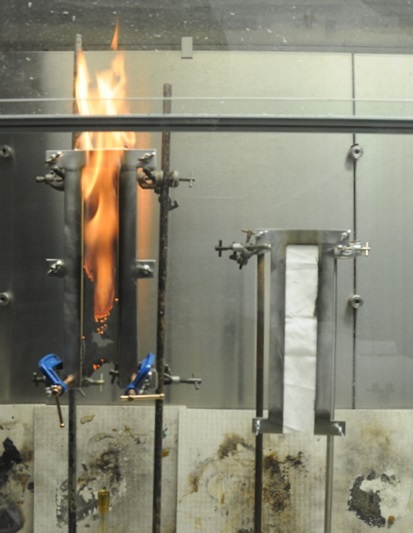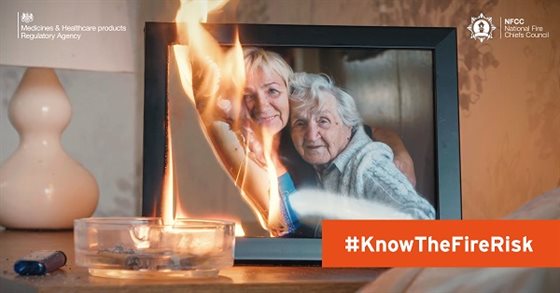Researchers have found that fabrics with skin creams and lotions dried on can catch fire significantly faster than clean material and therefore pose a serious risk of injury or even death.
Experts from De Montfort University Leicester (DMU) have started a new safety campaign to raise awareness of the flammability of skincare products, after research showed that even creams without paraffin made fabrics significantly more flammable when applied.
In a study led by Dr Sarah Hall from the Leicester School of Pharmacy at DMU, scientists spread a thin and even layer of various emollient moisturisers on different materials and allowed them to dry for 24 hours.
For each test, the fabric was placed inside a metal frame that sat above a naked flame, ensuring it never came into direct contact.

They found the materials set alight significantly faster compared to those that had no cream on – for example, a cotton polyester strip took around 10 minutes to ignite, yet all of the fabrics which were spread with moisturiser went up in flames in less than 14 seconds.
“When you see the burns that are associated with skin creams on fabrics, you can tell there is a big difference in the burn behaviour,” said Dr Hall. “The main thing that sticks out though is that the ignition time is much quicker.
“It makes you realise that people just wouldn’t have time to react and that is why there is a serious risk of severe and fatal burns.”
Since 2010 there have been 56 confirmed fire deaths linked to emollient creams in England. A review found that those most at risk tend to be over 60, smokers and have reduced mobility.
Thousands of people use emollient creams daily to manage dry, itchy or scaly skin conditions such as eczema and psoriasis, so they are easily transferred from skin on to clothing and bedding. The creams alone are not flammable, nor are they flammable when on the body.
However, the fire risk increases with every application of the cream as it transfers, dries and builds up on the fabric. Some cream remains even when the items are washed, so it’s important to minimise the risk in additional ways, such as removing long sleeved or loose clothing before cooking or using a safety lighter.
In 2018, as a direct result of Dr Hall’s work, the Medicines and Healthcare products Regulatory Agency (MHRA) recommended that labelling of emollients and similar prescribed products should have larger, clearer and more visible warnings had to be printed on packaging to encourage safer use and highlight the fire risk.
“It’s really important that people realise you do not have to come into direct contact with a naked flame for the fabric to burn,” continued Dr Hall. “The dried residue on clothing, bedding or any other material, makes it flammable.”
Initially it was thought that only creams with high paraffin content were flammable, however Dr Hall’s research found that non-paraffin creams also ignite rapidly.
To raise awareness of the dangers associated with emollients, Dr Hall and the MHRA have partnered with the National Fire Chiefs Council (NFCC) for a new campaign called #KnowTheFireRisk.

The MHRA recommends that anyone in the high-risk group, or their carers, should arrange a fire service assessment of their personal surroundings. They are also urged to exercise caution when close to naked flames or potential ignition sources (for example, lighting a cigarette).
Sarah Branch, Director of MHRA’s Vigilance and Risk Management of Medicines Division, said: “We want to ensure that those who are at greatest risk, and their carers, understand the fire risk associated with the build-up of residue on clothing and bedding and take action to minimise the risk.
“Anyone who uses emollients and has any questions or concerns should speak to a healthcare professional, such as your pharmacist or GP.”
Rick Hylton, NFCC’s Home Safety Committee Lead said: “We now know that all emollients, combined with factors such as smoking or mobility issues, pose potential fire risks and this applies to both paraffin and paraffin-free products. Washing fabrics does not fully remove this risk.
“This doesn’t mean people shouldn’t use these products but we urge people to follow the updated fire safety advice.
“If you use these products and smoke, don’t do so when wearing clothes or bandages that may have dried on emollients. Don’t smoke in bed as bedding may have residue on it and be careful around other heat sources such as gas, halogen or open fires and when cooking.”
For more information about the safe use of emollients visit: www.gov.uk/guidance/safe-use-of-emollient-skin-creams-to-treat-dry-skin-conditions
Posted on Wednesday 29 July 2020